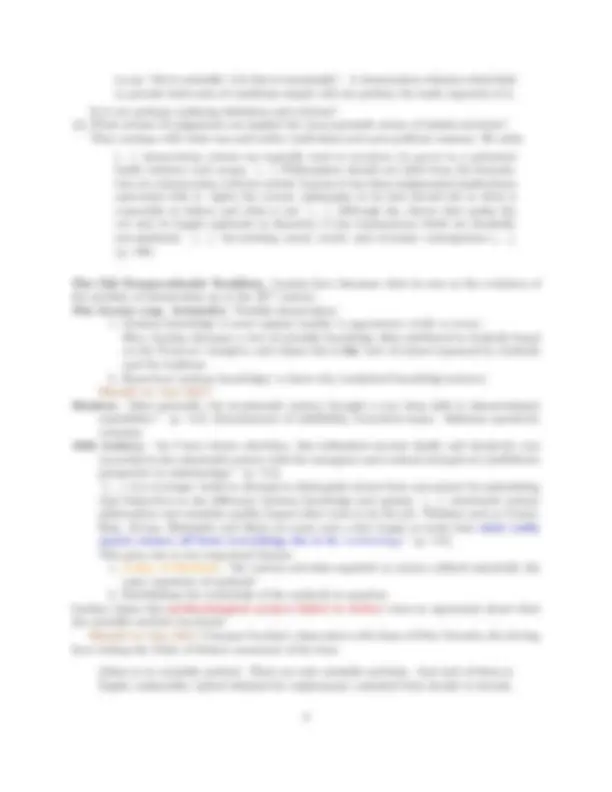




Study with the several resources on Docsity

Earn points by helping other students or get them with a premium plan


Prepare for your exams
Study with the several resources on Docsity

Earn points to download
Earn points by helping other students or get them with a premium plan
Community
Ask the community for help and clear up your study doubts
Discover the best universities in your country according to Docsity users
Free resources
Download our free guides on studying techniques, anxiety management strategies, and thesis advice from Docsity tutors
In this paper, nic fillion discusses larry laudan's views on the demarcation problem in science. Laudan argues that there is no clear demarcation line between science and non-science or pseudo-science. He suggests that the problem of demarcation is a pseudo-problem and that we should focus on epistemic and methodological questions about knowledge claims instead of trying to define science through a demarcation criterion. Laudan's arguments draw from historical traditions and cover topics such as scientific realism, scientific change, and the history of demarcationist sensibilities.
What you will learn
Typology: Slides
1 / 4

This page cannot be seen from the preview
Don't miss anything!



Discussion of “The Demise of the Demarcation Problem” (1983) by Larry Laudan by Nic Fillion, SFU, September 2, 2020
Let’s start with a gem: Laudan has a compelling style; his arguments draw from multiple historical traditions; he presents a clear perspective on complex problems.
His views are unavoidable on questions of scientific realism (pessimistic induction), scientific change (research traditions), and scientific demarcation, among others. He typically tries to capture the historical trajectory of a problem to draw general conclusions about the problem and its (proposed) solution(s). I suggest we first discuss the problem itself, and only discuss his historical case in detail if there’s time.
Why do we want a criterion of demarcation? He proposes a bunch of reasons in the opening paragraph (p. 111):
Controversial science is in the news all this time...
Laudan’s main thesis. His view is that “philosophy has largely failed to deliver the relevant goods” (p. 111). In more details:
[... ] it is probably fair to say that there is no demarcation line between science and non-science, or between science and pseudo-science, which would win assent from a ma- jority of philosophers. Now is there one which should win acceptance from philosophers or anyone else [... ]. [... ] it may just be that there are no epistemic features which all and only the disciplines we accept as ‘scientific’ share in common. (p. 112)
Towards the end of the paper, he puts in along those lines (p. 124):
[... ] we have learned enough about what passes for science in our culture to be able to say quite confidently that it is not all cut from the same epistemic cloth.
The evident epistemic heterogeneity of the activities and beliefs customarily regarded as scientific should alert us to the probably futility of seeking an epistemic version of a demarcation criterion. Where, even after detailed analysis, there appear to be no epistemic invariants, one if well advised not to take their existence from granted. But to say as much is in effect to say that the problem of demarcation [... ] is spurious, for that problem presupposes the existence of such invariants.
Put bluntly: the problem of demarcation is a pseudo-problem.
Where would that leave us, according to Laudan?
For his potentially more controversial theses, Laudan is very good at explaining that “no, no, that’s just an ordinary thesis we should all get behind.”
Now, even if we agreed with Laudan on this, there is still plenty to argue about...
What conditions would a criterion have to satisfy? In his Section 3, A Metaphilosophical Interlude, Laudan discusses three central questions concerning criteria of scientificity. Among other things, Laudan here builds a bridge between his descriptive and normative claims about science (which is very important!). (1) What conditions of adequacy should a proposed demarcation criterion satisfy? It can no longer be entirely stipulative a priori (“uncompromisingly legislative”). Any proposed dividing line between science and non-science would have to be (at least in part) explicative and thus sensitive to existing patterns of usage. Accordingly, if one were today to offer a definition of ‘science’ which classified (say) the major theories of physics and chemistry as non-scientific, one would thereby have failed to reconstruct some paradigmatic cases of the use of the term. (p. 117) But more than capturing usage is needed: But we expect more than this of a philosophically significant demarcation criterion between science and non-science. Minimally, we expect a demarcation criterion to identify the epistemic or methodological features which mark off scientific beliefs from unscientific ones. We want to know what, if anything, is special about the knowledge claims and the modes of inquiry of the sciences. (p. 118)
(2) Should it offer both necessary and sufficient conditions for scientific status?
Without conditions which are both necessary and sufficient, we are never in a position
from discipline to discipline, even from lab to lab.
That’s basically what Laudan says, but with opposite conclusion!
The New Demarcationist Tradition. According to Laudan, this new tradition arises as a result of the Vienna circle’s syntactic and logical approach to the matter (p. 120). According to him, they replaced methodological attempts by attempts based on a theory of meaning: verifiability, meaningfulness, and scientific character all coincide. According to Laudan, this project of using a theory of meaning as a criterion of demarcation was an unmitigated disaster:
The new demarcationism thus reveals itself as a largely toothless wonder, which serves neither to explicate the paradigmatic usages of ‘scientific’ (and its cognates) nor to per- form the critical stable-cleaning chores for which it was originally intended. (p. 122)
But is it really what was happening, or was it the beginning of a re-birth of method- ology?
The last gem is cursed: it’s about Laudan’s occasionally slanted historical depiction (in my opinion, of course). It serves its dramatic effect, but can be misleading.